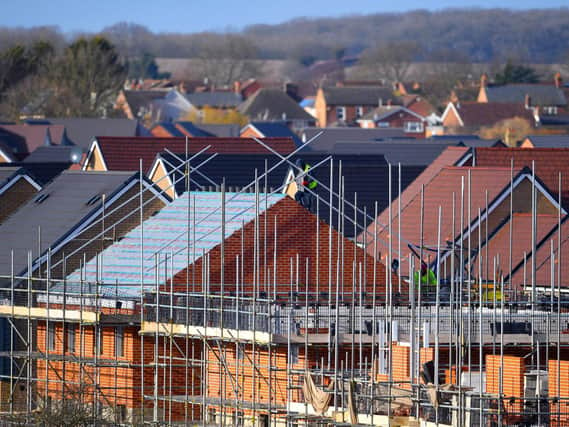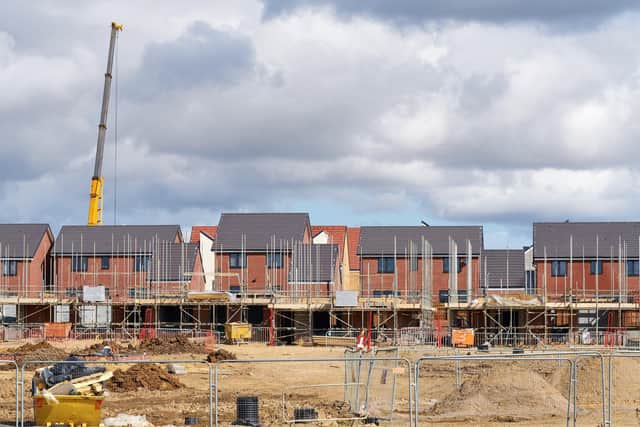The future of our housing: Are we building too many homes in Leamington, Warwick and Kenilworth?


The issue of housing has been a contentious one for many years for towns, cities and villages across the country - and the Warwick district is no exception. Central Government has instructed every local authority to provide more homes to meet the housing shortages. But Warwick and Leamington MP believes this needs challenging - and that we could end up with a surplus of 4,000 homes that could ‘change Warwick district forever’. We spoke to people on both sides of the story to find out more.
It is hard not to notice new homes popping up on fields around Leamington, Warwick and Kenilworth.
Advertisement
Hide AdAdvertisement
Hide AdMany have been fought by local residents who are angry over the rapid growth of our towns. Others have welcomed a chance to move to their own home in a desirable location.


But are the figures right? The housing requirement for Warwick District Local Plan, covering the period 2011-2029, is 16,776, or 932 per year. This annual figure is made up of two elements; 600 homes to meet Warwick district’s housing need and 332 to meet the housing needs of Coventry.
Matt Western, Warwick and Leamington MP, believes these figures need challenging - and that we could end up with a surplus of about 4,000 homes that could ‘change Warwick district forever’.
He has looked at some analysis compiled by ex-council planner and architect of 40 years, Ray Bullen, who suggests up to 20,751 new dwellings will be delivered in the same time frame - 3,975 over the current provision.
Advertisement
Hide AdAdvertisement
Hide AdHis research also questions the way the government calculates regional housing need.
The Labour MP is also concerned about the 332 of the 923 homes to be built every year in Warwick district under the Local Plan to cater for Coventry’s housing need that cannot be achieved within the city’s boundaries.
The homes needed in one housing area that are built outside its boundary in neighbouring districts are often referred to as ‘overspill’.
For years campaigners have complained revised Office for National Statistics (ONS) data is unaccounted for in often-refuted Local Plans.
Advertisement
Hide AdAdvertisement
Hide AdFor instance, if 2018 rather than 2014 ONS projections are considered for Coventry, about 5,000 fewer ‘overspill’ homes are needed in surrounding areas, Mr Bullen claims.
Warwick District Council (WDC) says its approach, and this housing split, was fully and extensively debated at a public inquiry before the current Local Plan was adopted and was supported by the independent inspector in allowing the council to adopt the plan.
"The calculation of housing need for all local authorities in England is undertaken using a 'standard methodology' set by Government," said a spokesperson for WDC.
"There has been much debate recently about this 'standard methodology' and last autumn the Government undertook a public consultation into changes they proposed to make to it.
Advertisement
Hide AdAdvertisement
Hide Ad"It is from this that the annual figure of 627 homes per year for Warwick district has now been calculated.
"This figure relates to the housing needs of Warwick district (not any additional housing to meet the needs of Coventry) and so should be compared directly with the figure of 600 home per year in the current Local Plan, not the overall figure of 932 homes.
"In terms of the extent to which Warwick district will continue to meet the housing needs of Coventry city in the future, this is currently 332 per year. However will be reviewed as part of the review of Warwick district’s Local Plan."
In Coventry, research undertaken by the Keep Our Green Belt Green group claims the city’s housing need could be less than half that outlined in its Local Plan and in ONS figures – mainly due to a failure to account for departing students.
Advertisement
Hide AdAdvertisement
Hide AdMr Western says such analyses makes a compelling case that the true number of Coventry ‘overspill’ homes to be built in Warwick could also be much lower.
He said: “Due to a reliance on potentially inaccurate calculations, many more homes could be built per year than are needed in our district.
“The implications of this overdevelopment are wide-reaching and affect the lives of thousands of residents.
“For example, hundreds of Sydenham residents are threatened by the creation of the East Whitnash 200-home giant cul-de-sac – which will cause traffic, road safety and air quality concerns.
Advertisement
Hide AdAdvertisement
Hide Ad“Mark my words, if these figures are not revised at least in line with more recent ONS data, but preferably in line with figures Mr Bullen and other campaigners have revealed, developers will continue to build unsustainable developments carte blanche.
“Neighbourhoods will be irreparably changed, and green belt will be forever lost.”
Mr Western has called for the Warwick district Local Plan to be altered to more accurately reflect the district’s housing need.
Warwick District Council said the housing figures are always being examined and that a joint review has just begun with Stratford District Council as part of a single South Warwickshire Local Plan.
Advertisement
Hide AdAdvertisement
Hide AdA spokesperson said: "There is a government requirement for Local Plans to take account of the housing needs of surrounding areas and agree how unmet needs can be met and the council needs to continue to do this.
"Whilst these discussions have not taken place yet, it should be noted that whilst the revisions to the Government’s standard methodology proposed broadly similar figures for housing needs in Warwick district, they propose significantly higher figures for Coventry city (the 2017 standard methodology proposed 1,722 homes per year for Coventry and this has increased to 2,325 in 2020).
"Unless the government makes further changes to the rules by which housing requirements should be calculated and distributed, this housing need for Coventry city will need to be met either within the city or in adjacent districts such as Warwick district."
Cllr Andrew Day, leader of Warwick District Council, said the Local Plan was adopted 'following a rigorous process, including an examination in public led by an independent inspector'.
Advertisement
Hide AdAdvertisement
Hide AdHe also pointed out that while the Warwick district plans to take on an additional 332 new homes a year to meet part of Coventry's housing need, Stratford and North Warwickshire plan to meet some of Birmingham's 'overspill' housing needs.
"The key point to appreciate is that Warwick district is not an island and is required in planning law to cooperate with neighbouring authorities in creating our Local Plan," he said.
But he also shares concerns about the accuracy of the housing forecasts for Coventry and the knock-on implication for the number of 'overspill' housing Warwick district has been required to meet (i.e. 300 a year).
"However, before we jump to conclusions, we really should wait for the response from the ONS, which is due in July," he added.
Advertisement
Hide AdAdvertisement
Hide Ad"It is also important to note in this debate that the Government has updated the standard methodology for calculating the new housing requirements for each local planning authority area. When we apply this new methodology, the forecast housing need for Warwick District is 624 new houses a year, a slight increase over 600 new homes we have included in the current Local Plan.
"More importantly, using this new methodology the assessed housing need for Coventry has significantly increased from 1,722 to 2,325 new homes per year.
Cllr Day added: "Those who are calling for a review of our Local Plan will no doubt be pleased to learn that this process is already underway.
"In fact, when the current Local Plan was adopted in 2017, the review process was scheduled to be completed by 2023, which is why last summer we agreed to begin, working with Stratford-on-Avon District Council to create a Local Plan for all of south Warwickshire.
Advertisement
Hide AdAdvertisement
Hide Ad"We're making good progress with this important task, with governance arrangements agreed; a consultation on the scope for the Local Plan review underway and a 'call for sites' recently announced. These are the first steps in a process that will take some time to complete, but thankfully our current Local Plan will remain in force in the meantime."
The council leader said that the debate on new housing should also concentrate on the positive effects for the district.
"I have noted references to particular sites which I won’t comment upon as they are the subject to a planning application and an appeal, but I do think it is regrettably that the commentary on new housing is dominated by negative arguments, with little or no recognition that houses are 'homes' for local families," he added.
"It is important to remember that people suffer when they don’t have access to good quality homes and I believe that we haven’t had enough affordable housing; we need more of good quality; more that are carbon neutral and all supported by first-rate community infrastructure.
"That is what a good Local Plan can deliver for our community, which is why my focus will be, rather than on furthering academic arguments about what could happen, but probably never will."